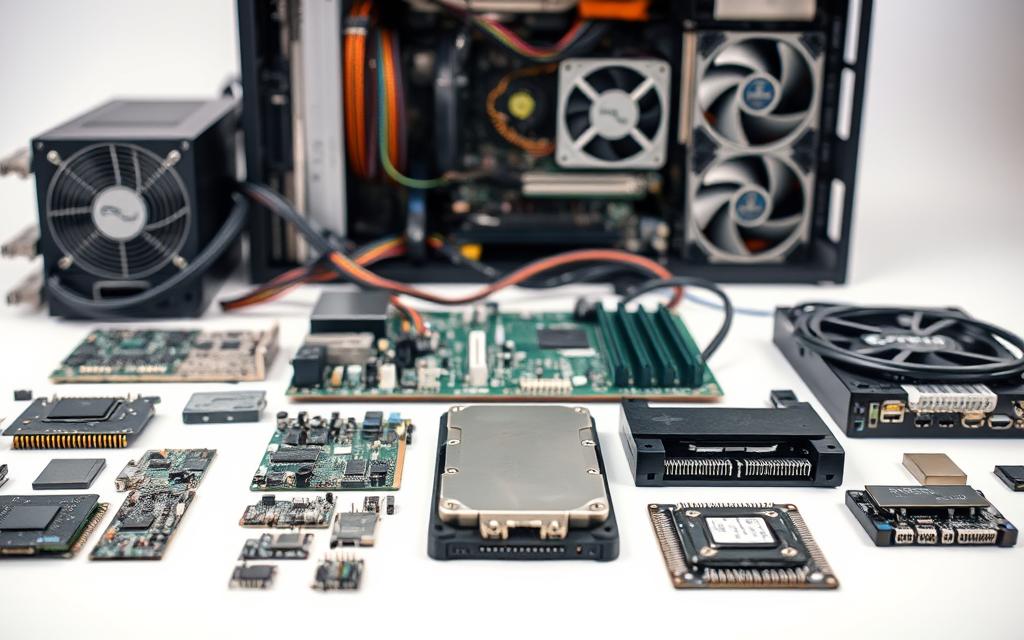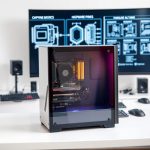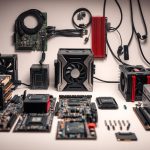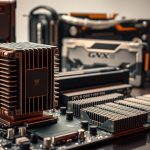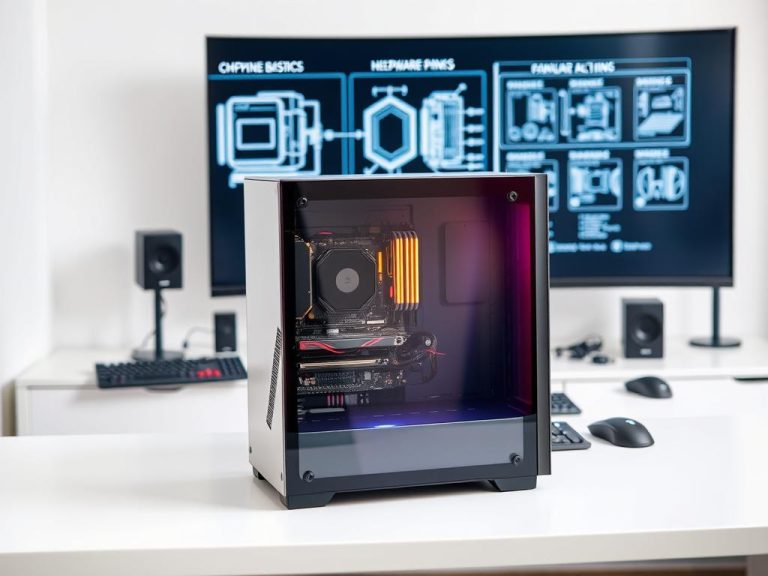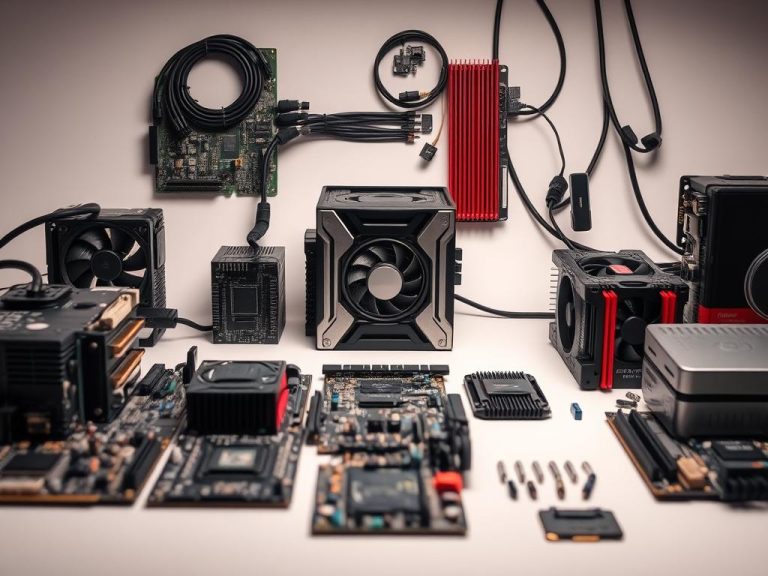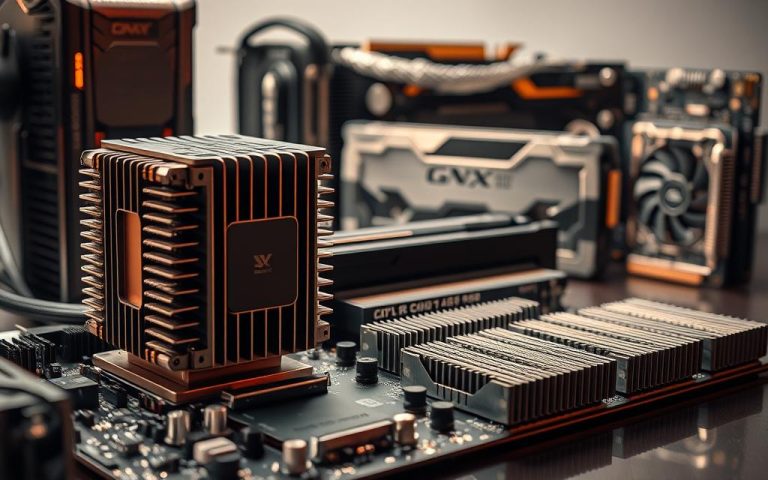A Guide to the Various Types of Computer Hardware
Every computing system relies on hardware components to function. These physical parts, like CPUs, RAM, and storage devices, work with software to execute tasks. From mechanical calculators in the 1600s to today’s smartphones, advancements have been remarkable.
Early innovations, such as Pascal’s gear-based adder, paved the way for modern technology. Now, internal components and peripherals collaborate seamlessly. Moore’s Law highlights how performance doubles roughly every two years.
Understanding these devices helps optimize performance. Key categories include processing units, memory, and input/output tools. Whether building a PC or upgrading a laptop, knowing the basics ensures smarter decisions.
What Are the Different Types of Computer Hardware
Computers function through a blend of physical and digital elements. Hardware refers to tangible parts like CPUs and motherboards, while software comprises coded instructions. Together, they enable tasks from simple calculations to complex simulations.
Defining Hardware vs. Software
The key difference lies in tangibility. Hardware includes physical components such as hard drives and GPUs. Software, like operating systems, directs these devices to perform tasks. Von Neumann’s 1945 architecture unified memory for both data and programs, revolutionizing design.
Boolean algebra underpins circuit logic, enabling efficient processing. However, the Von Neumann bottleneck limits speed when memory access delays the CPU. Parallel processing mitigates this by dividing tasks across multiple cores.
Core Categories of Hardware Components
All hardware serves four primary functions:
- Input: Keyboards, mice, or touchscreens capture user commands.
- Processing: CPUs and GPUs execute calculations.
- Output: Monitors and speakers display results.
- Storage: SSDs and HDDs retain data long-term.
| Architecture | Instruction Set | Use Case |
|---|---|---|
| CISC | Complex, multi-step | Desktops, servers |
| RISC | Simple, fast | Mobile devices, embedded systems |
CISC processors handle varied tasks, while RISC chips prioritize speed. Modern systems often blend both for optimal performance.
Essential Internal Hardware Components
Behind every efficient system lies a carefully assembled set of core hardware parts. These components determine speed, stability, and multitasking capabilities. Upgrading or troubleshooting requires understanding their roles.
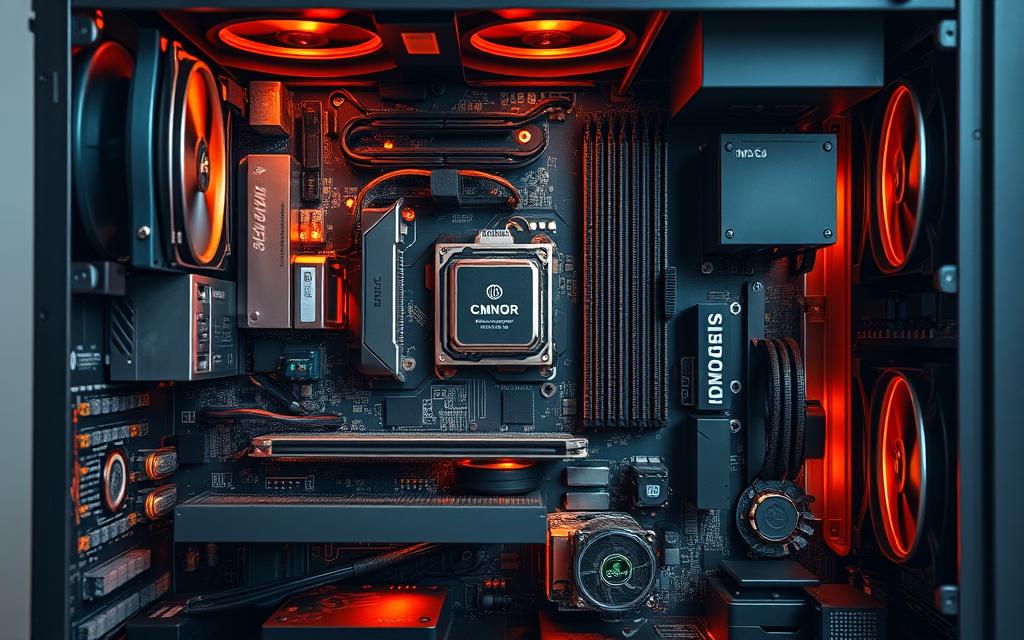
Central Processing Unit: The Brain
The CPU executes billions of calculations per second using MOSFET transistors. Modern chips, like Intel’s i9 or AMD’s Ryzen, pack over 10 billion transistors. Clock speeds range from 1 GHz for basic tasks to 5 GHz for gaming rigs.
Multi-core designs split workloads across parallel processing units. A quad-core CPU handles four tasks simultaneously, reducing lag. Cache memory (L1/L2/L3) accelerates data access, bridging the gap between RAM and the processor.
“Moore’s Law isn’t dead—it’s evolving. Chipmakers now focus on efficiency, not just transistor count.”
Motherboard: The Nervous System
This circuit board connects all system components. Motherboards use VRMs (Voltage Regulator Modules) to deliver stable power to the CPU. High-end models feature 12+ VRM phases for overclocking.
Chipsets manage data flow:
- Northbridge: Handles CPU, RAM, and GPU communication (integrated into modern CPUs).
- Southbridge: Controls slower I/O like USB and SATA ports.
| CPU Type | Clock Speed Range | Use Case |
|---|---|---|
| Budget | 1–3 GHz | Office tasks, browsing |
| High-End | 3–5 GHz | Gaming, video editing |
RAM and ROM: Memory Essentials
RAM (Random Access Memory) stores active tasks temporarily. Volatile by design, it clears when powered off. DDR4 and DDR5 modules offer speeds up to 6400 MT/s for seamless multitasking.
ROM (Read-Only Memory) retains critical firmware like BIOS/UEFI. A CMOS battery preserves date/time settings during shutdowns. The memory hierarchy prioritizes speed:
- Registers (fastest, inside CPU)
- L1/L2/L3 cache
- DRAM (main memory)
- Storage (SSD/HDD, slowest)
Storage Devices: Where Your Data Lives
Your files and applications need a reliable place to reside. Storage devices preserve data even when power is off, from family photos to critical work documents. Choices range from spinning disks to lightning-fast chips.
Hard Disk Drives vs. Solid-State Drives
HDDs use magnetic platters spinning at 7200 RPM. They excel in affordability and capacity, ideal for backups. However, moving parts make them slower and prone to damage.
SSDs rely on NAND flash memory with no mechanical components. They boot systems in seconds and withstand shocks. Though pricier per gigabyte, their speed justifies the cost for active workloads.
| Metric | HDD | SSD |
|---|---|---|
| Speed | 120 MB/s | 550 MB/s+ |
| Durability | 5 years avg. | 10+ years |
Hybrid Drives and Flash Storage
Hybrid drives combine HDD capacity with SSD speed. Frequently accessed files auto-migrate to the flash portion. This balances performance and cost for budget-conscious users.
Flash devices like USB drives and SD cards use similar tech to SSDs. Speed classes matter:
- UHS-I: Up to 104 MB/s (cameras, basic storage)
- UHS-II: 312 MB/s (4K video, pro photography)
Optical Media: CDs to Blu-ray
Discs remain relevant for archiving. Blu-ray lasers (405nm) store 128GB, dwarfing DVDs (4.7GB). However, cloud services have reduced their everyday use.
“3D NAND stacking lets modern SSDs pack terabytes into thumb-sized chips.”
Power Supply and Cooling Systems
A stable power supply and efficient cooling are critical for any high-performance system. Without proper voltage regulation and heat dissipation, even top-tier hardware can underperform or fail prematurely.
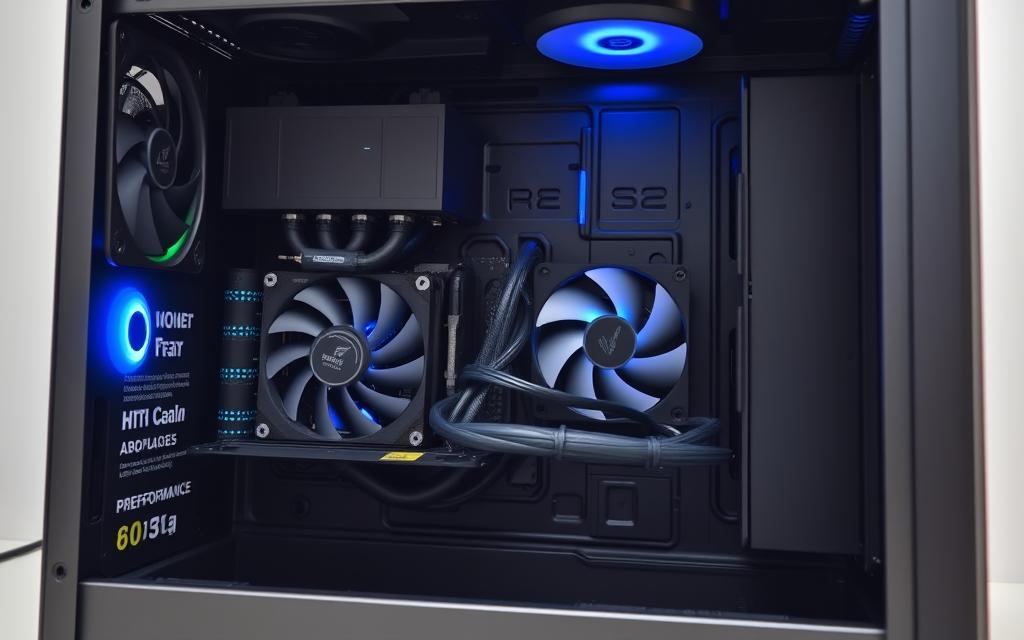
Voltage Regulation and Energy Efficiency
Modern ATX power supply units convert 120-277V AC to 3.3V, 5V, and 12V DC. The 12V rail handles most demands, especially for GPUs and CPUs. Switched-mode designs outperform linear models by minimizing energy waste.
Look for 80 Plus certification when choosing a PSU:
- Bronze: 82% efficiency at 50% load
- Gold: 90% efficiency, ideal for gaming rigs
- Titanium: 94% efficiency, best for servers
Active Power Factor Correction (PFC) further enhances performance by smoothing voltage fluctuations. High-quality VRMs and capacitors ensure stable delivery during peak loads.
Air vs. Liquid Cooling for Optimal Performance
Air cooling uses aluminum or copper heat sinks with PWM-controlled fans. It’s cost-effective and suits most builds. For extreme workloads, liquid cooling circulates coolant through a radiator, handling 500W+ TDPs quietly.
| Cooling Type | Noise Level | Max TDP |
|---|---|---|
| Air | Moderate | 250W |
| Liquid | Low | 500W+ |
“Thermal throttling activates at 100°C to prevent damage, but consistent high temps shorten component lifespan.”
Advanced solutions like immersion cooling submerge entire systems in dielectric fluid. Data centers use this for unmatched heat dissipation. For everyday users, quality thermal paste between CPUs and coolers improves heat transfer by up to 15°C.
Input Devices: How You Communicate with Your Computer
Interacting with digital systems requires tools that translate human actions into commands. Input devices bridge this gap, letting users control and navigate seamlessly. From typing documents to gaming, these peripherals shape how we engage with technology.

Keyboards, Mice, and Touchscreens
Keyboards come in two main designs. Mechanical versions use individual switches for each key, offering tactile feedback. Membrane models are quieter but less precise. Gamers often prefer mechanical types for their responsiveness.
Modern mice feature adjustable DPI settings. High-end gaming models reach 16,000+ DPI for pixel-perfect accuracy. Ergonomic designs reduce wrist strain during long sessions.
Touchscreens rely on two primary technologies:
- Resistive: Pressure-sensitive layers work with any stylus.
- Capacitive: Responds to finger touches with higher clarity.
| Device | Best Use Case | Key Feature |
|---|---|---|
| Mechanical Keyboard | Gaming, typing | Customizable switches |
| Gaming Mouse | Precision tasks | Adjustable DPI |
| Capacitive Touchscreen | Mobile devices | Multi-touch support |
Specialized Input Tools for Accessibility
Innovative solutions help users with limited mobility. Eye-tracking systems let ALS patients control cursors through gaze. Voice recognition software converts speech to text with 95%+ accuracy.
Other assistive technologies include:
- Braille keyboards for visually impaired users
- Foot pedals as alternative pointing devices
- Head-controlled mice for quadriplegic individuals
“Surface acoustic wave touchscreens withstand 50 million touches, making them ideal for public kiosks.”
Biometric devices like fingerprint scanners add security. They authenticate users in seconds. Haptic feedback enhances virtual interactions by simulating textures and resistance.
For more on how these tools integrate with operating systems, explore our guide on computer device functionality.
Output Devices: How Your Computer Communicates with You
Visual and auditory feedback transforms raw data into meaningful experiences. Output devices translate digital signals into forms humans perceive. Whether watching movies or printing reports, these tools shape how we consume information.
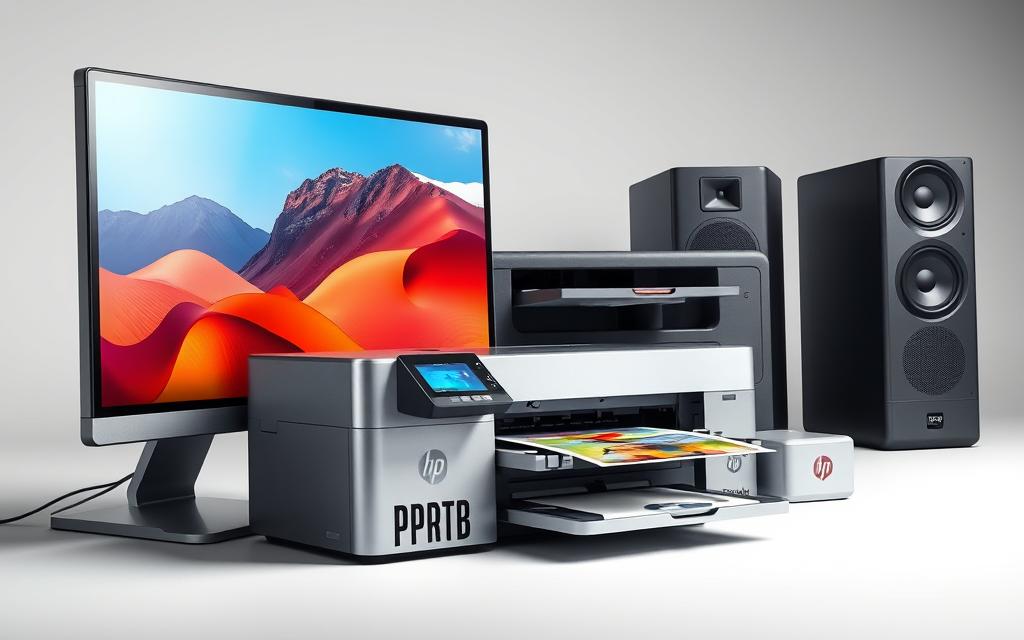
Monitors: LCD, LED, and 4K Displays
Modern monitors showcase vibrant visuals with resolutions up to 3840×2160 pixels. OLED panels deliver perfect blacks by turning off individual pixels. QLED enhances brightness for sunlit rooms.
Key specs define performance:
- Refresh rates: 144Hz eliminates motion blur for gamers
- HDR10: Expands color range for cinematic contrast
- Response time: 1ms GTG reduces ghosting in fast scenes
| Display Type | Contrast Ratio | Best For |
|---|---|---|
| LCD | 1000:1 | Budget setups |
| OLED | Infinite | Creative work |
Printers: From Inkjet to 3D
Printers create physical copies with precision. Laser models use electrostatic toner for sharp text at 30+ pages per minute. Inkjets excel in photo reproduction with microscopic droplet control.
3D printers build objects layer by layer:
- FDM: Melts plastic filament (50-100 micron layers)
- SLA: Cures liquid resin with UV light (25 micron precision)
“Industrial 3D printers now craft titanium aircraft parts with 5-micron accuracy.”
Speakers and Headphones for Audio Output
THX-certified devices reproduce studio-quality sound. Dolby Atmos adds height channels for 3D audio effects. Noise-canceling headphones block 35dB of ambient noise.
Audio formats compared:
- DTS:X: Object-based sound positioning
- PCM: Uncompressed CD-quality audio
Wireless models use Bluetooth 5.0 for lag-free streaming. Audiophile-grade wired options support 32-bit/384kHz resolution.
The Evolution of Computer Hardware
Technology has transformed dramatically since the first computing devices emerged. Early machines filled entire rooms, while today’s hardware fits in pockets yet delivers unmatched performance. This journey reflects human ingenuity and relentless innovation.
In 1971, the Intel 4004 chip held just 2,300 transistors. Compare that to Apple’s M2 Ultra with 134 billion. Moore’s Law predicted this growth, but modern advancements now push beyond silicon limits.
Key milestones shaped this evolution:
- 1940s-1950s: Vacuum tubes gave way to smaller, more reliable transistors
- 1970s: Microprocessors enabled personal computers
- 2000s: Multi-core CPUs and GPUs revolutionized processing power
Storage capacity exploded from 5MB in 1956 to today’s 30TB drives. Data transfer speeds jumped too – USB 1.1’s 12Mbps seems laughable next to USB4’s 40Gbps throughput.
“Quantum computing represents the next frontier, with qubits performing calculations impossible for classical systems.”
Modern GPUs illustrate this progress. Once simple 2D accelerators, they now handle AI training and photorealistic rendering. Neuromorphic chips mimic human brain structures, enabling new machine learning approaches.
This rapid advancement continues reshaping how we interact with technology. From room-sized mainframes to wearable devices, hardware evolution never stops. Explore how these systems integrate in our guide on computer system architectures.
Large-Scale and Specialized Computer Systems
Powerhouse computing solutions drive industries and daily life behind the scenes. These systems range from room-sized mainframes to microscopic chips in smart devices. Each serves unique applications, ensuring reliability where it matters most.
Mainframes and Supercomputers
The IBM z16 mainframe processes 19 billion transactions daily—equivalent to every credit card swipe on Earth. Built for banks and governments, these systems prioritize RAS: Reliability, Availability, and Serviceability. Redundant components allow repairs without shutdowns.
Supercomputers tackle tasks like climate modeling and nuclear research. TOP500 benchmarks rank their exascale performance—1 quintillion calculations per second. Unlike mainframes, they optimize raw speed over transaction volume.
| Feature | Mainframes | Supercomputers |
|---|---|---|
| Primary Use | High-volume transactions | Complex simulations |
| Key Metric | Transactions/day (e.g., 19B) | FLOPS (e.g., 1 exaFLOP) |
Embedded Systems in Everyday Devices
ARM Cortex-M chips power smart thermostats and wearables. These processing units balance efficiency with compact size. Automotive ECUs (Electronic Control Units) in modern cars manage fuel injection and safety features.
Medical embedded systems include pacemakers with fail-safe designs. Edge computing shifts data analysis closer to devices, reducing cloud dependence. FPGAs offer reprogrammable logic, while ASICs deliver fixed, high-speed performance.
“The Raspberry Pi democratized embedded development, enabling DIY projects with industrial-grade components.”
Virtual Hardware and Cloud Computing
Modern enterprises increasingly rely on abstracted infrastructure solutions. Cloud computing eliminates physical hardware constraints through dynamic resource allocation. Services like AWS EC2 provide virtualized CPUs and RAM that scale instantly.
Hypervisors manage these virtual environments efficiently. Type 1 versions run directly on hardware for maximum performance, while Type 2 operates atop host operating systems. AWS Nitro System achieves near-bare-metal speeds through dedicated chipsets.
Containerization offers lightweight alternatives to full virtualization. Unlike virtual machines that emulate entire systems, containers share the host OS kernel. This reduces overhead for microservice-based applications.
| Solution | Isolation Level | Boot Time |
|---|---|---|
| Virtual Machine | Hardware-level | 30-60 seconds |
| Container | Process-level | 1-2 seconds |
Cloud providers tier storage based on access frequency. Hot tiers serve active data with sub-millisecond latency, while archive tiers cost 80% less for rarely accessed files. Automated policies move content between tiers.
“Serverless architectures execute code without provisioning servers, scaling to zero when idle.”
Disaster recovery leverages cloud replication across zones. Virtual SANs synchronize storage between locations, enabling failover within minutes. GPU passthrough allows virtual machines direct graphics processor access for rendering workloads.
How to Choose the Right Hardware for Your Needs
Selecting optimal components requires balancing speed, budget, and longevity. Whether building a gaming PC or upgrading office workstations, strategic choices prevent overspending and premature obsolescence.
Balancing Performance, Cost, and Future-Proofing
Benchmark tools like Cinebench (CPU) and 3DMark (GPU) reveal real-world performance. A 1080p gamer might prioritize a mid-range RTX 3060, while 4K editing demands an RTX 4080’s 16GB VRAM.
| Resolution | Recommended GPU | VRAM Requirement |
|---|---|---|
| 1080p | RTX 3060 / RX 6600 | 8GB |
| 4K | RTX 4080 / RX 7900 XT | 16GB+ |
Upgradeability hinges on socket compatibility (AM5/LGA1700) and available DIMM slots. Energy Star-certified hardware cuts long-term cost by 30% through efficient power use.
Total Cost of Ownership (TCO) includes:
- Warranty periods (3–5 years for enterprise)
- Scalable storage (NVMe slots for expansion)
- E-waste reduction via modular designs
“A $200 GPU today may cost $400 in replacements if it can’t handle next-gen software.”
For offices, standardized OS setups streamline workflows. Gamers should prioritize GPU speed and cooling. Always check manufacturer support—some brands offer lifetime warranties on select components.
Conclusion
Modern technology thrives on powerful physical foundations. Hardware drives digital transformation, enabling breakthroughs from healthcare to entertainment. Matching components to specific needs ensures optimal performance.
Emerging trends like photonic chips and eco-friendly manufacturing reshape the landscape. Regular maintenance extends the lifespan of devices, while upgrades keep systems competitive.
From everyday laptops to quantum supercomputers, these physical parts remain the backbone of innovation. Invest wisely, maintain diligently, and harness their full potential.
FAQ
What is the difference between hardware and software?
Hardware refers to the physical components of a computer, like the CPU, motherboard, and storage devices. Software includes programs and operating systems that run on the hardware to perform tasks.
Why is the CPU considered the brain of a computer?
The Central Processing Unit (CPU) executes instructions, performs calculations, and manages data flow, making it the core component for processing tasks.
How does RAM differ from storage drives?
A: RAM (Random Access Memory) is temporary memory used for active tasks, while storage drives (HDDs, SSDs) retain data even when the system is powered off.
What are the advantages of SSDs over HDDs?
A: Solid-State Drives (SSDs) offer faster speeds, lower power consumption, and greater durability compared to traditional Hard Disk Drives (HDDs).
Why is cooling important for computer hardware?
Cooling systems prevent overheating, ensuring stable performance and extending the lifespan of components like the CPU and GPU.
What are the main types of input devices?
Keyboards, mice, touchscreens, and specialized tools like graphics tablets allow users to interact with their systems efficiently.
How do monitors impact user experience?
Display quality, resolution (such as 4K), and panel type (LCD, LED) affect visual clarity, making monitors a crucial output device.
What are embedded systems?
These are specialized hardware setups integrated into devices like smart appliances, medical equipment, and automotive systems for dedicated functions.
Can cloud computing replace physical hardware?
While cloud services reduce dependency on local storage, physical hardware like servers and networking devices remain essential for infrastructure.
How do I choose the right hardware for my needs?
Consider performance requirements, budget, and future scalability—balancing speed, storage capacity, and compatibility with software applications.
